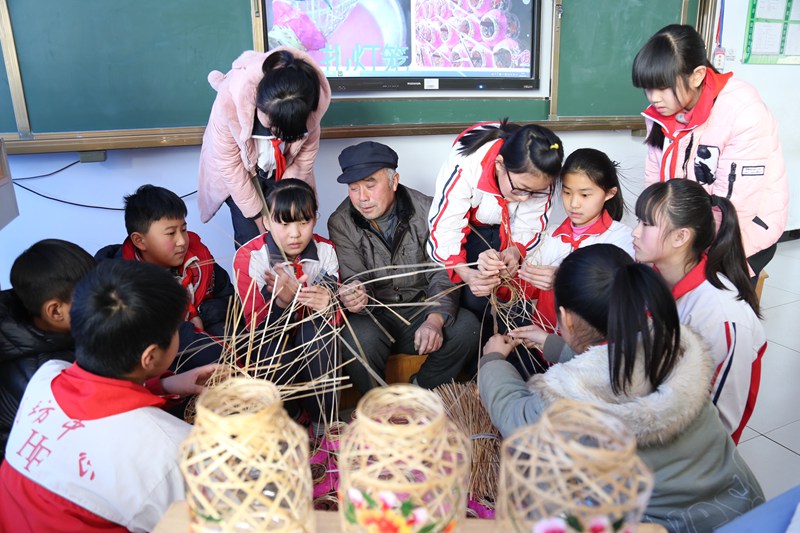

 |
| Zhang Hongbin teaches students how to make lanterns in an activity aimed at promoting intangible cultural heritages at a local school. (People’s Daily Online/Wang Jun) |
Villagers in Hefang neighborhood, Huimin county, east China's Shandong province, have secured a steady income for their families by producing handmade lanterns for the Lantern Festival, the 15th day of the Chinese Lunar New Year.
The tradition of producing handmade lanterns in Hefang dates back to the reign of Xuande Emperor (1399-1435) of the Ming Dynasty, and the craft has been designated as a local intangible cultural heritage. According to local custom, children hold up lanterns during the Festival to pray for longevity.
Unlike round lanterns, the reed and paper lanterns made in Hefang are long, enclosed by glass-paper covered with flower patterns, animals and Chinese characters around the main body and red glazed paper near both ends.
Zhang Hongbin, who is in his 60s, is an inheritor of the intangible cultural heritage. Awarded the title of "excellent cultural talent in Shandong's rural areas", he began learning the craft from his father when he was 14 years old and has been producing handmade lanterns for over 50 years.
While passing forward the traditional process of lantern making that he learnt from his father, Zhang also introduces innovations into his works by designing new graphic patterns on the glass paper so that they keep up with the times.
In recent years, Zhang has been selling his lanterns through online e-commerce platforms. In the 45 days from the last lunar month of 2020 to the Lantern Festival, Zhang sold more than 3,000 handmade lanterns for more than 10,000 yuan ($1,547).
Over 100 households from about six surrounding villages have been engaged in the lantern-making business, earning an average household income of over 20,000 yuan each year, reports have confirmed.
 |

 Award-winning photos show poverty reduction achievements in NE China's Jilin province
Award-winning photos show poverty reduction achievements in NE China's Jilin province People dance to greet advent of New Year in Ameiqituo Town, Guizhou
People dance to greet advent of New Year in Ameiqituo Town, Guizhou Fire brigade in Shanghai holds group wedding
Fire brigade in Shanghai holds group wedding Tourists enjoy ice sculptures in Datan Town, north China
Tourists enjoy ice sculptures in Datan Town, north China Sunset scenery of Dayan Pagoda in Xi'an
Sunset scenery of Dayan Pagoda in Xi'an Tourists have fun at scenic spot in Nanlong Town, NW China
Tourists have fun at scenic spot in Nanlong Town, NW China Harbin attracts tourists by making best use of ice in winter
Harbin attracts tourists by making best use of ice in winter In pics: FIS Alpine Ski Women's World Cup Slalom
In pics: FIS Alpine Ski Women's World Cup Slalom Black-necked cranes rest at reservoir in Lhunzhub County, Lhasa
Black-necked cranes rest at reservoir in Lhunzhub County, Lhasa China's FAST telescope will be available to foreign scientists in April
China's FAST telescope will be available to foreign scientists in April